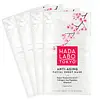What's inside
What's inside
 Key Ingredients
Key Ingredients

 Benefits
Benefits

 Concerns
Concerns

No concerns
 Ingredients Side-by-side
Ingredients Side-by-side

Water
Skin ConditioningGlycerin
HumectantButylene Glycol
HumectantDipropylene Glycol
HumectantNiacinamide
SmoothingGlyceryl Polymethacrylate
Squalane
EmollientErythritol
HumectantPolyglyceryl-10 Myristate
Skin Conditioning1,2-Hexanediol
Skin ConditioningXanthan Gum
EmulsifyingAmmonium Acryloyldimethyltaurate/Vp Copolymer
Allantoin
Skin ConditioningPolyglyceryl-10 Laurate
Skin ConditioningGlyceryl Caprylate
EmollientAcrylates/C10-30 Alkyl Acrylate Crosspolymer
Emulsion StabilisingArginine
MaskingCentella Asiatica Extract
CleansingAdenosine
Skin ConditioningEthylhexylglycerin
Skin ConditioningPaeonia Suffruticosa Root Extract
Skin ProtectingChamomilla Recutita Flower Extract
MaskingDisodium EDTA
Parfum
MaskingAchillea Millefolium Extract
CleansingDextrin
AbsorbentTheobroma Cacao Extract
Skin ConditioningHydrogenated Lecithin
EmulsifyingLimonene
PerfumingSodium Hyaluronate
HumectantCamellia Sinensis Leaf Extract
AntimicrobialCeramide NP
Skin ConditioningHyaluronic Acid
HumectantWater, Glycerin, Butylene Glycol, Dipropylene Glycol, Niacinamide, Glyceryl Polymethacrylate, Squalane, Erythritol, Polyglyceryl-10 Myristate, 1,2-Hexanediol, Xanthan Gum, Ammonium Acryloyldimethyltaurate/Vp Copolymer, Allantoin, Polyglyceryl-10 Laurate, Glyceryl Caprylate, Acrylates/C10-30 Alkyl Acrylate Crosspolymer, Arginine, Centella Asiatica Extract, Adenosine, Ethylhexylglycerin, Paeonia Suffruticosa Root Extract, Chamomilla Recutita Flower Extract, Disodium EDTA, Parfum, Achillea Millefolium Extract, Dextrin, Theobroma Cacao Extract, Hydrogenated Lecithin, Limonene, Sodium Hyaluronate, Camellia Sinensis Leaf Extract, Ceramide NP, Hyaluronic Acid
Water
Skin ConditioningButylene Glycol
HumectantGlycerin
HumectantPentylene Glycol
Skin ConditioningBHT
AntioxidantCaprylic/Capric Triglyceride
MaskingCarbomer
Emulsion StabilisingDisodium EDTA
Hydrolyzed Collagen
EmollientHydrolyzed Hyaluronic Acid
HumectantHydrolyzed Soy Protein
HumectantHydroxyethylcellulose
Emulsion StabilisingIodopropynyl Butylcarbamate
PreservativePEG-20 Sorbitan Isostearate
EmulsifyingPhenoxyethanol
PreservativePPG-10 Methyl Glucose Ether
Skin ConditioningSodium Acetylated Hyaluronate
HumectantSodium Hyaluronate
HumectantTocopheryl Acetate
AntioxidantTriethanolamine
BufferingWater, Butylene Glycol, Glycerin, Pentylene Glycol, BHT, Caprylic/Capric Triglyceride, Carbomer, Disodium EDTA, Hydrolyzed Collagen, Hydrolyzed Hyaluronic Acid, Hydrolyzed Soy Protein, Hydroxyethylcellulose, Iodopropynyl Butylcarbamate, PEG-20 Sorbitan Isostearate, Phenoxyethanol, PPG-10 Methyl Glucose Ether, Sodium Acetylated Hyaluronate, Sodium Hyaluronate, Tocopheryl Acetate, Triethanolamine
Ingredients Explained
These ingredients are found in both products.
Ingredients higher up in an ingredient list are typically present in a larger amount.
Butylene Glycol (or BG) is used within cosmetic products for a few different reasons:
Overall, Butylene Glycol is a safe and well-rounded ingredient that works well with other ingredients.
Though this ingredient works well with most skin types, some people with sensitive skin may experience a reaction such as allergic rashes, closed comedones, or itchiness.
Learn more about Butylene GlycolDisodium EDTA plays a role in making products more stable by aiding other preservatives.
It is a chelating agent, meaning it neutralizes metal ions that may be found in a product.
Disodium EDTA is a salt of edetic acid and is found to be safe in cosmetic ingredients.
Learn more about Disodium EDTAGlycerin is already naturally found in your skin. It helps moisturize and protect your skin.
A study from 2016 found glycerin to be more effective as a humectant than AHAs and hyaluronic acid.
As a humectant, it helps the skin stay hydrated by pulling moisture to your skin. The low molecular weight of glycerin allows it to pull moisture into the deeper layers of your skin.
Hydrated skin improves your skin barrier; Your skin barrier helps protect against irritants and bacteria.
Glycerin has also been found to have antimicrobial and antiviral properties. Due to these properties, glycerin is often used in wound and burn treatments.
In cosmetics, glycerin is usually derived from plants such as soybean or palm. However, it can also be sourced from animals, such as tallow or animal fat.
This ingredient is organic, colorless, odorless, and non-toxic.
Glycerin is the name for this ingredient in American English. British English uses Glycerol/Glycerine.
Learn more about GlycerinSodium Hyaluronate is hyaluronic acid's salt form. It is commonly derived from the sodium salt of hyaluronic acid.
Like hyaluronic acid, it is great at holding water and acts as a humectant. This makes it a great skin hydrating ingredient.
Sodium Hyaluronate is naturally occurring in our bodies and is mostly found in eye fluid and joints.
These are some other common types of Hyaluronic Acid:
Learn more about Sodium HyaluronateWater. It's the most common cosmetic ingredient of all. You'll usually see it at the top of ingredient lists, meaning that it makes up the largest part of the product.
So why is it so popular? Water most often acts as a solvent - this means that it helps dissolve other ingredients into the formulation.
You'll also recognize water as that liquid we all need to stay alive. If you see this, drink a glass of water. Stay hydrated!
Learn more about Water